All things slings: SC&RA news January 2020
06 March 2020

Al Abel, lifting specialist at Mazzella Companies (Cleveland, Ohio, USA), took part in an SC&RA webinar entitled: How Well Do You Know the Basics of Lifting Slings & Rigging Hardware?
Comprising an in-depth examination of the fundamentals needed to perform care, use and inspect lifting slings and rigging hardware, Abel’s presentation underscored the industry standards expected of companies to operate safely. Attendees walked away with a more focused understanding of how to care for and operate wire rope, chain and web slings and an assortment of below-the-hook lifting devices. They also gained valuable insight into the inspection process: dos and don’ts, frequency, removal criteria, ID tags and more.

With Mazzella since 1995, Abel joined the company while concurrently finishing up a high school teaching career with the Cleveland public school system. Since then, he’s been instrumental in developing and expanding Mazzella’s training programmes and mentoring and developing other trainers within the organisation.
Abel reflects on 30 years of teaching as preparation for his training experiences now, though he never looks past the fact that he still learns something every day. “Let’s be honest, when you talk about accident causation, you’re basically trying to save lives, and this webinar was unique in that I’m used to being in front of my audience and reacting to them – but in this case, I had to make certain adjustments.”
Key points
A typical onsite training session with Abel will involve a wealth of visuals and hands-on opportunities for attendees. And it usually starts with a visit and walk-through ahead of time.
“The first thing I like to do with a company is see what they’re doing and create the training around that,” he indicated. “Obviously, with this webinar, we approached it differently – utilising four of our eleven modules that we train from. It was very similar to what folks would see in a live class – and we added to the experience by incorporating some visuals through PowerPoint and even some videos.”
Top on Abel’s priority list for the webinar were inspections. “Key points I wanted to hit were: what is the rejection criteria for when a rigger is on a jobsite – when you pick up a sling? And how often should you be inspecting a sling,” he noted. “The audience should always be keeping a close eye on their lifting equipment, and ultimately thinking, ‘When would I not put this into service?’ When I present, I also want to make sure that people understand that this isn’t what I say – we’re going by the ASME standards. Don’t shoot the messenger.”
Onsite, Abel will often require his audience to develop a lift plan. “We’ll typically do that before we get into the rejection criteria – all the things you have to think about when making a lift,” he pointed out. “And, of course, one of the key points in a lift plan is inspection. So, we covered that carefully in the webinar; if I’d have been in front of them, they’d leave with a lift plan, but the webinar was more of a walk-through in that regard.”

Getting better
Occasionally, someone in Abel’s audience tosses him an unusual question, but for the most part, he knows what to expect. “People often ask about latches for some reason, and slings,” he said. “When it comes to why people sometimes hide these devices from inspectors, one thing you don’t want to hear is ‘…the company’s not going to buy me a replacement.’ If I hear that, I try to put it on the table with the company up front.”
As for his digital audience, Abel emphasised that if folks took the time to tune in, they should take his information seriously. “If someone attended, or attends, this webinar, and they go back to doing something that they know is wrong, then they’ve failed,” he said. “The point here is that everyone is trying to get better.”
Part of getting better often means implementing industry advancements. “Probably the most consistent innovations at this point deal with tagging,” Abel explained. “A computer spits this tag out and it meets all the industry standards, very durable – that’s probably the nicest thing that has happened in recent times. But I never want to hear a company say: we go through a lot of slings. If you’re doing that, same with latches, something’s wrong. If you’re tearing up latches and slings, we need to look at how you’re operating.”
Homemade lifting devices is another area of concern for Abel. “Whether it’s a spreader beam or a lift beam, if it’s going below the hook, it’s got to meet all industry standards. If you’ve got a welder and he’s welding up some kind of a lift beam, whose name is going on that beam? Because it’s got to a have a manufacturer on it, proper markings, a serial number, a rated load, a design category, a service class and, if it doesn’t, then it won’t pass the current standards.”
It’s pay now or pay later in the long run, he added. “I mean, I’m an old guy – I remember cars without seat belts – but try buying one like that today. You’ve still got a lot of people thinking old-school in this industry, thinking they’re going to save their company some money. But eventually, they’re going to cost them more money if they don’t take action here and do things the right way.”

Can’t say enough
More often, Abel’s role as a trainer brings him in front of other undeniable realities that impact industry. “One thing I’m noticing more and more: who’s picking up the work after these older guys leave?” he stressed. “The current workforce is definitely used to the tech, the interactive stuff, and maybe a webinar works for them. When we’re in-person, I do know they like the mix of verbal, hands-on, and video – which is also why we added that [video] for this webinar. Young people are very visual learners, especially these days, so we tried to recreate that at least a little in this webinar.”
Ultimately, Abel recognised SC&RA’s dedication to its membership in offering the chance for someone like him to come in and do his part. “Just being asked to do this type of thing – I printed the list of past webinars SC&RA has done,” he said. “There’s a ton of topics; my first thought was, holy cow. The Association is ahead of the curve – putting so much information out there. The best part about this webinar is that if you miss it, you can circle back and find it on SC&RA’s website and join in at a time that works best for you. You can’t say enough about an organisation that does it like this, and I’m happy to be a part of it.”
To register for upcoming webinars and view archived presentations, see: www.scranet.org/webinars





